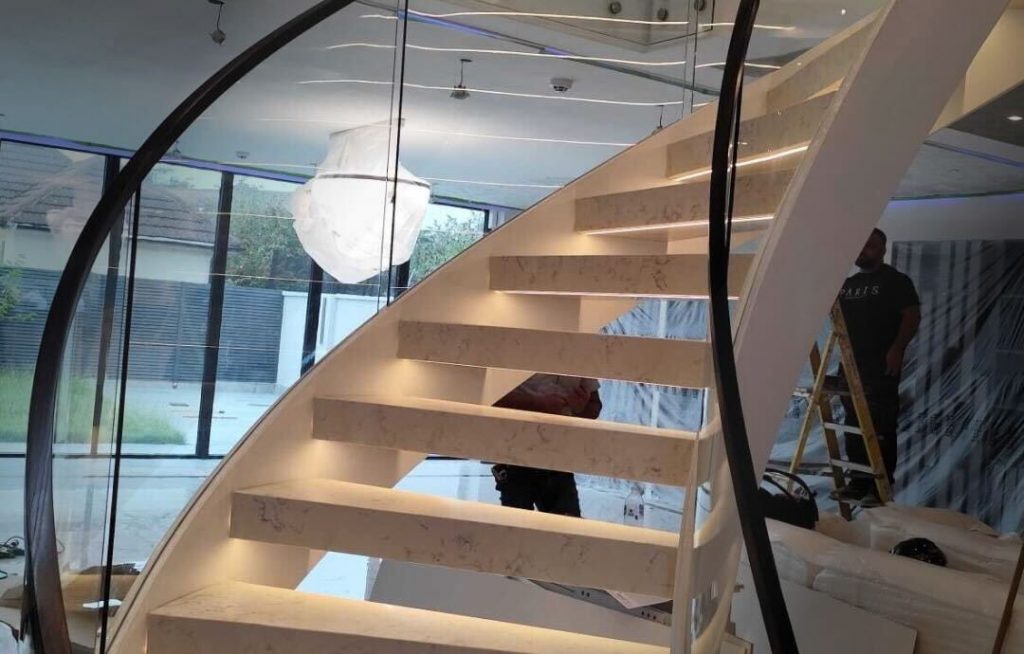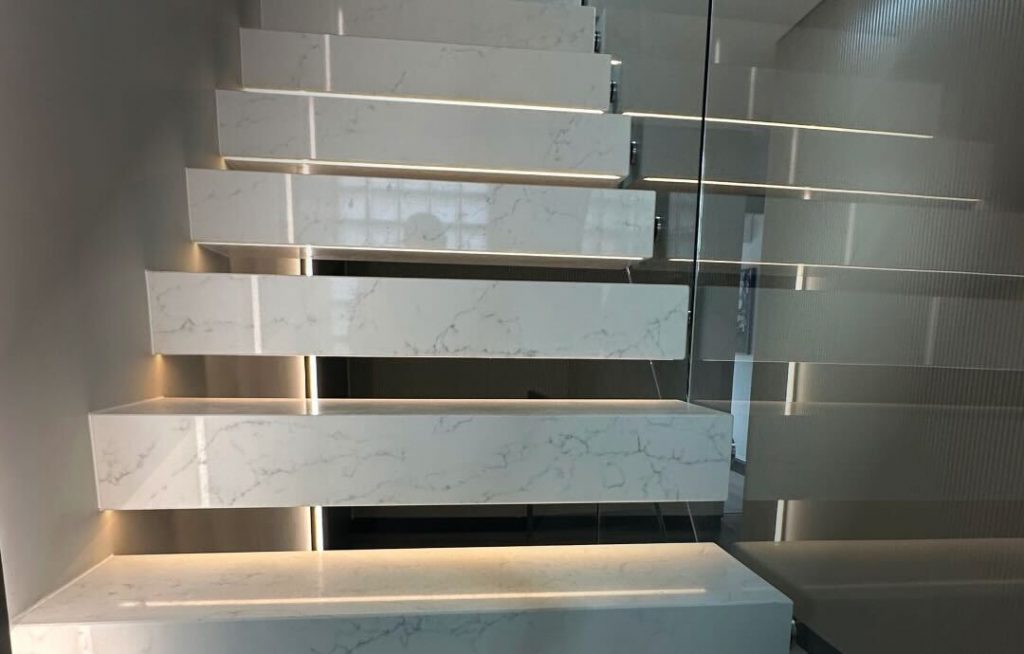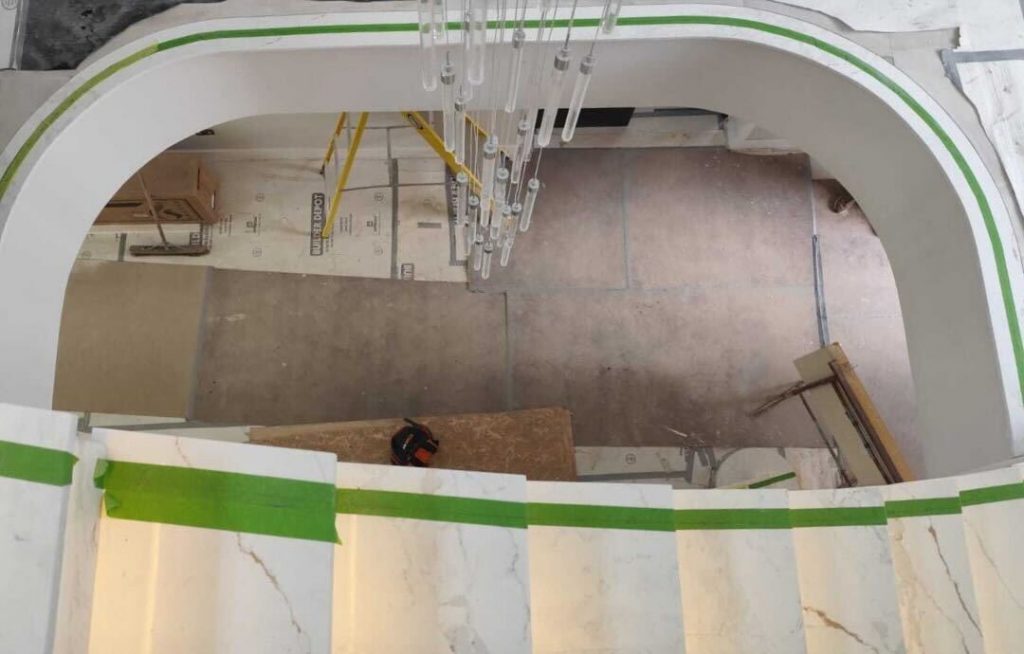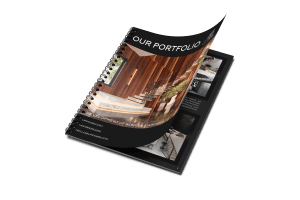Pros and Cons of Using Quartz in Bespoke Staircases
Have you ever wondered what materials are most commonly used for staircase projects? There can be a lot of debate on this subject, as the modern market offers many options. It all depends on your personal preferences, the overall interior design of the room, your budget, and other factors. For example, when choosing between different types of stone, many homeowners prefer quartz. Why is that?
One of the main reasons is its affordable cost. However, this is not the only factor contributing to its popularity. Based on V.PSTAIRS personal experience, it has been one of our customers’ most frequent choices over the past year. That is why we have something to share with you in this article. We would like to tell you more about quartz stone and how it is used in the creation of balustrades and steps. Here we go!
Quartz and Its Main Features

Quartz in staircase design typically means engineered stone: ground quartz bound with polymer resins and pigments, pressed and cured into rigid slabs. As a composite, it behaves predictably, offering consistent dimensions and appearance across pieces while still requiring careful detailing for support, edges, and exposure.
- Engineered composition: predominantly ground quartz with polymer binders and mineral pigments.
- High mass and density.
- Supplied as slabs in standard thicknesses (commonly 20–30 mm) with edge build-ups used to achieve deeper nosings.
- Sensitivity to prolonged UV exposure.
In bespoke staircases, these characteristics steer key decisions. We mean span and fixing strategy, nosing build-ups, finish selection for safe traction, joint placement, and whether the location is suitable (e.g., interior vs. sun-exposed areas).
Advantages and Disadvantages of Using Quartz in Staircases Compared to Alternatives
It is no secret that the modern market offers a wide range of alternatives for steps, risers, handrails and other staircase elements. For example, V.PSTAIRS offers a variety of alternative staircase materials, from which you can choose the most suitable option (glass, different types of wood, other types of stone and metal). However, most of our customers choose quartz stone after consulting with our manager. Below, we have prepared a comparative table of the advantages and disadvantages of using quartz stone in staircase projects.
Pros | Cons |
|---|---|
Low porosity. Better stain resistance than limestone, marble, or timber. | Complexity. Complex curves, thick edge build-ups, and on-site jointing can erode savings. |
Easy upkeep. Usually, it needs only mild cleaners. | Unnatural. Can read as “manufactured” and less characterful than marble, granite or solid wood. |
High surface hardness. Resists everyday scuffing better than timber or laminate. | Brittle at edges. Chips from point impacts are more likely than with hardwood or metal nosings. |
Cost-effective pricing. Often cheaper than premium marble, with stable costs across colourways. |
Another advantage is the wide variety of colours available. This is a unique material because it can be produced in virtually any shade of the rainbow. To explore all the quartz stone options available for your future staircase, please contact us in any way convenient for you.
Are you considering using wood for your project? Discover the best types of wood we use for staircases → https://vpstairs.com/best-types-of-wood-for-staircases-personal-experience-of-v-pstairs/
1. Steps

Quartz is widely used to face steps and risers on steel, timber or concrete flights when continuous support is provided. Standard slabs (20–30 mm) are templated precisely. Joints are planned at landings to keep seams discreet. Edges are lightly arrised to reduce chipping, and corner protection can be added on busy routes.
Finish selection is crucial: polished reads crisp but may be slippery when wet, whereas honed or textured surfaces, and anti-slip inserts improve traction and compliance. Allow for movement with perimeter breaks and shadow gaps. Choose mid-tone colours that conceal dust and scuffs, and specify neutral cleaners to preserve gloss and avoid resin bloom.
2. Balustrades
Quartz in balustrades is typically a cladding and capping material rather than a free-spanning infill. Designers apply it to newel wraps, plinths, stringer facings and handrail caps to deliver a wipe-clean surface. Panels are kept short to manage weight and achieve neat joints. The finish resists scuffs, but vulnerable corners benefit from arrises or protective trims.
Because slabs are heavy, structure comes from a hidden core (steel, laminated glass or studwork), while quartz provides the visible skin. Shadow gaps accommodate thermal movement, and UV-sensitive ranges are avoided in sunlit atria. Explore our portfolio of balustrades to discover a wealth of inspiring projects!
Our Approach to Working with Quartz Stone

Our approach to quartz is disciplined and transparent. We procure slabs no thinner than 20 mm, then inspect each piece for structural integrity, uniformity and batch consistency. Before any purchase, we consult on colour and shade, reviewing samples under project lighting. We map veins, optimise yield and edge details, and agree finishes to balance slip-resistance, maintenance and aesthetics and durability.
Get a Free Consultation with Experts
As we mentioned above, the modern market offers a wide range of options when it comes to building bespoke staircases. On the one hand, this is good news, but on the other, it complicates the final choice for beginners. The best solution is to start by consulting with experts in staircase installation in the UK. This will help you hear the opinions of professionals and learn all the nuances and pitfalls of each material.
If you have any ideas for your future staircase project, let us know and we will get back to you as soon as possible. We will study your wishes, requirements and any ideas to convert them into a ready-made solution. That is why you can contact us today in any convenient way:
- hello@vpstairs.com
- +44 7418 315550
- Monday to Friday 8:00 AM to 6:00 PM
We have dozens of unique and inspiring projects under our belt. We look forward to hearing from you so that we can provide you with expert assistance!
3 Comments
-
Jack Mitchell
Quartz steps are less durable than other alternatives, such as marble. This makes them more vulnerable to heavy loads.
-
vpstairs
Thank you for your comment, Jack! In fact, all our products undergo initial load-bearing tests. We use only high-quality materials, including quartz stone, which is a durable material.
-
Comments are closed.


Isabella Cooper
I think that most people choose quartz because of its cost – in my humble opinion.